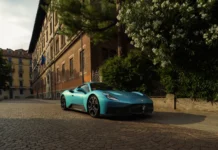
Supra vs. 86: Can Toyota’s sports car revival crush its older sibling?
It would be bold to claim Toyota has changed the playing field for sports cars with the new GR Supra because they perfected something that the world might no longer need. Now that the long wait is over, will it send its little brother—the 86—into retirement. Or will both agile sports cars of different eras find a comfortable place in Toyota’s product line into the foreseeable future?
A little history
Toyota rebadged the FR-S to 86 when the Scion brand was shuttered. Originally introduced as the 2013 Scion FR-S, it boasted lightweight fun in a compact package with 200 ponies sending power to the rear wheels through a six-speed manual transmission and a limited-slip differential. For drivers not challenged by low ceilings and economy-class legroom, positioning is near perfect—the shifter, the steering wheel, the pedals—are precisely where you want them.

On the other hand, the Supra’s heritage spans several decades and four generations, until US sales halted with the 1998 model year. Regaining a new lease on life, made possible by collaborating with BMW, the fifth-generation Supra arrived amidst immense fanfare and delight from sports car enthusiasts.
The Supra, after a 22-year hiatus, makes a comeback equipped with a turbocharged inline six-cylinder engine, rear-wheel drive, and several styling cues that pay homage to its family legacy.
So how does the A90 Supra compare to the 86, and does it irrefutably dominate the lesser-powered coupe?
My compliments to the designers
Some of the exterior design inspiration for the Toyota 86 comes from the Sports 800 and 2000GT built in the sixties. Step back a few feet, and you’ll notice it has a clean and compact shape that’s not overdone.
The mild front fender bulges convey a muscular element underneath the hood. From the side, the shark-nosed two-seater has a relatively short hood and soft flowing lines over the passenger cabin. The backside view is low and wide.
The fifth-generation Supra, with its swoopy styling, has an intriguing design influenced by Toyota’s classic line-up of sports cars such as the 2000GT, Celica, early Supras, and even the FR-S.
The Supra’s long nose and aggressive bulges show off Toyota’s focus on design flow and belie its seductiveness. The car’s aerodynamics captures the elements of emotion and energy that does a damn good job of raising one’s blood pressure.
Light ’em up!
Set your expectation sights on low, and the 86 comes back feeling surprisingly responsive and engaging. Handling is tight, and the electronically assisted steering will provide modest feedback and oodles of fun.
Sadly, low power, wait-for-it acceleration and rigid suspension remind you of the coupe’s weaknesses—however, its nimble handling and predictive tail-spin tip the fun-meter to the plus side.
One fundamental factor that differentiates the 86 and Supra is that the former has an available six-speed manual transmission. The modern Supra only comes with an eight-speed automatic. In terms of connecting the driver and machine, there’s no substitute for stirring the gears manually.
If you can overcome the old-school thinking and accept shifting on the fly using paddles or switching the transmission to manual mode, then that satisfying feeling of flying down your favorite ribbon of asphalt will be fulfilling.
Breaking down the performance elements is fine, but the GR Supra delivers a solid dose of pizzazz and punch. Whereas the 86 has some excellent sports car traits—but the GR Supra, taken as the whole enchilada—is truly excellent.
For me, it’s not just how the GR Supra performs on the track, or how it accelerates or brakes on the road or closed course. It’s also how it sounds under hard acceleration, how engaging it can be for the driver, and how it can turn heads when it comes into view. Bottom line: it’s a high-performance vehicle that performs well beyond expectations and readily brings on the feeling of nirvana.
Truth be told, the Supra puts me in a much happier place than the 86 every day of the week.
Finish line
A persistent quibble about the 86 (FR-S/BRZ) is the car’s less-than-adequate power output—205 horsepower from a normally aspirated 2.0-liter boxer-four. A quick survey of the outdated cabin and electronics doesn’t help boost the agile sports car’s image to any degree. I concede that the 86 is a light and nimble sports car easily affordable but put it side-by-side with the Supra, and I’ll pick the curvaceous two-seater any day of the week.

An aggressive look and feel, advanced technology, and pulse-pounding performance all contribute to make the Supra a unique sports car and unforgettable as its ancestors. Prestige, performance and Supra’s heritage come together in a package that will always override the 86 from any angle.
| 2020 GR Supra | 2019 86 TRD | |
|---|---|---|
| MSRP | $53,990 | $32,470 |
| Price as tested | $57,259 | $33,425 |
| Engine | 3.0L turbocharged inline-6 | 2.0L 4-cylinder boxer |
| Power (hp) | 335 @ 6,500 rpm | 205 @ 7,000 rpm |
| Torque (lb-ft) | 365 @ 1,600 rpm | 156 @ 6,400 rpm |
| Transmission | 8-speed automatic | 6-speed manual |
| Drivetrain layout | rear-wheel-drive | rear-wheel drive |
| Curb weight | 3,388 lbs. | 2,837 lbs. |
| EPA-estimated fuel economy | 26 mpg (combined) | 24 mpg (combined) |
| Wheelbase | 97.2 inches | 101.2 inches |
| Length x width x height | 172.5 x 73.0 x 50.9 inches | 168.8 x 69.9 x 50.6 inches |
| Ground clearance | 4.5 inches | 4.9 inches. |
| Cargo volume | 10.0 cu. ft. | 10.5 cu. ft. |








































